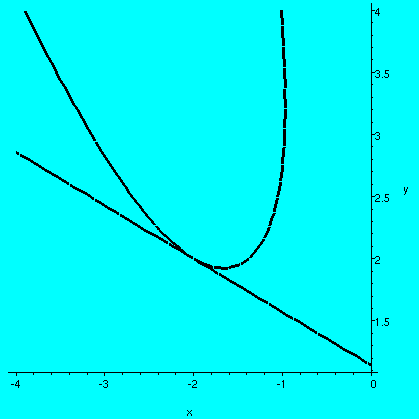 ANSWER: a: dy/dx= (-5y^2-4x^3)/(3y^2+10xy)
b: y=-(3/7)x+(8/7)
ANSWER: a: dy/dx= (-5y^2-4x^3)/(3y^2+10xy)
b: y=-(3/7)x+(8/7)
| Solutions | ||||
|---|---|---|---|---|
| D | E | P | Q | S2 a, b |
Problem D
Particle A moves along the positive x-axis
and particle B moves along the positive y-axis.
a) If $A$ is at the point (a,0) and B is at the point (0,b),
write an expression for the distance from A to B.
Solution
Expression for distance between A and B: Pythagorean Theorem gives... d^2 = a^2 + b^2 d = (a^2 + b^2)^(1/2)b) At a certain time, A is at the point (7,0) and moving away from the origin with a speed of 4 units/sec. At the same time B is at the point (0,5) and moving towards the origin at 2 units/sec. At what rate is the distance from A to B changing at that time? Are the particles moving towards each other or moving away from each other at that time?
Solution
Given: da/dt=-2 and db/dt=(t)=4 Chain rule... dd/dt=(1/2)[(a^2+b^2)^(-1/2)](2a(da/dt)+2b(db/dt)) a=7, b=5, a'=-2, b'=4 dd/dt=(1/2)[(7^2+5^2)^(-1/2)](2(7)(-2)+2(5)(4)) dd/dt=(1/2)[(74)^(-1/2)](12) dd/dt=6*sqrt(74) This value is positive so the particles are moving away from each other.Submitted by
Problem E
A particle is moving with the given data.
Find a formula for the position, s(t), of the particle at time t
if a(t)=cos(t)+sin(t), s(0)=0, and v(0)=5.
Solution
We know that (integral)a(t) = v(t) and (integral)v(t) = s(t) * a(t) = cos(t) + sin(t) (integral)a(t) = v(t) = sin(t) - cos(t) + C v(0) = 5 = 0 - 1 + C so C = 6 ** v(t) = sin(t) - cos(t) + 6 (integral)v(t) = s(t) = -cos(t) - sin(t) + 6t + C s(0) = 0 = -1 - 0 + 0 + C so C = 1 *** s(t) = -cos(t) - sin(t) + 6t + 1Submitted by
Problem P
Compute the integral from 1 to 2 of (3x^2- {4\over x^2}) using calculus.
Solution
To compute the integral take the antiderivative of the function.
2 2
S 3x^2 - (4/x^2) dx = I x^3 + (4/x)
1 1
Plug the two bounds in for x and subtract the top from the
bottom to find the value of the integral.
This = 8 + 2 - 1 - 4 = 10 - 5 = 5
Submitted by
Problem Q
For the curve y^3+5xy^2+x^4=-16 find
a) dy/dx
b) An equation of the line tangent to the curve at (-2,2)
Solution
a) dy/dx
(dy/dx both sides) y^3+5xy^2+x^4=-16
3y^2dy/dx+5y^2+10xydy/dx+4x^3=0
(solve for dy/dx) dy/dx(3y^2+10xy)= -5y^2-4x^3
dy/dx= (-5y^2-4x^3)/(3y^2+10xy)
b) An equation of the line tangent to the curve at (-2,2)
x=-2 and y=2. So: y=mx+b
where m is the slope which we already have in form of dy/dx
then dy/dx = (-5y^2-4x^3)/(3y^2+10xy) = m
m= [-5(2)^2-4(-2)^3]/[3(2)^2+10(-2)(2)] = -3/7
then in the equation y=mx+b we will solve for the value of b
2=-(3/7)(-2)+b so 2-(6/7)=b and b=(8/7).
Then the line tangent to the curve at (-2,2) is y=-(3/7)x+(8/7)
 ANSWER: a: dy/dx= (-5y^2-4x^3)/(3y^2+10xy)
b: y=-(3/7)x+(8/7)
ANSWER: a: dy/dx= (-5y^2-4x^3)/(3y^2+10xy)
b: y=-(3/7)x+(8/7)
Submitted by
Problem S2
Compute the following limits. Give exact answers, as necessary in
terms of well-known constants such as Pi, e, ln(3), sqrt{2},
etc.
a) limx-->0}[tan(17x)]/[sin(13x)]
b) limx-->infinity[sqrt(4+5x^4)]/[3+6x+7x^2]
c) limx-->1[ln(2x^2-1)]/[(x-1)ex]
Solution
a)lim tan(17x)/sin(13x)= L'H
x-0
0/0
lim [sec^2(17x)(17)] / [cos(13x)(13)] = 17/13
x-0
b) lim [(4+5x^4)^(1/2)]/[3+6x+7x^2] =
x-00 (infinity)
00/00 divide everything by x^2
lim [{(4+5x^4)(1/x^4)}^(1/2)]/[(3+6x+7x^2)(1/x^2)] = [(5)^(1/2)]/7
x-00
Submitted by